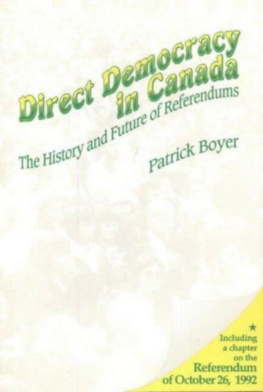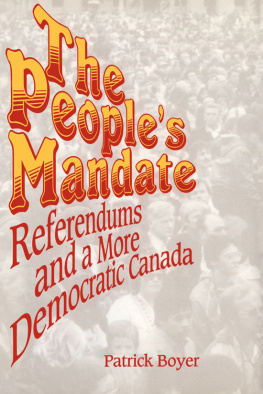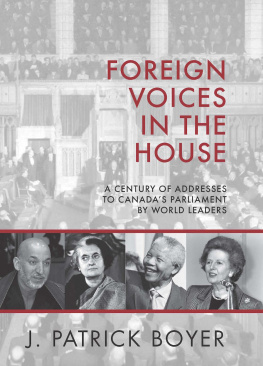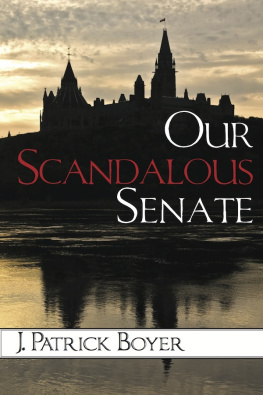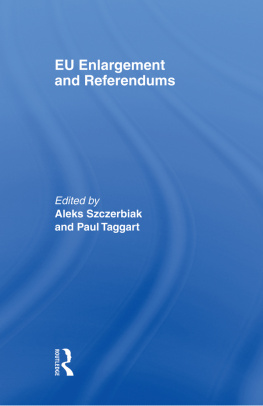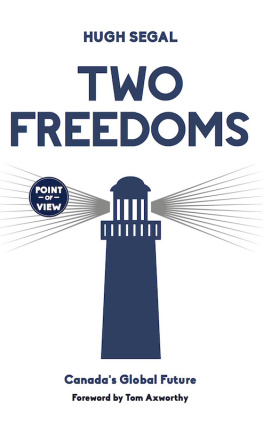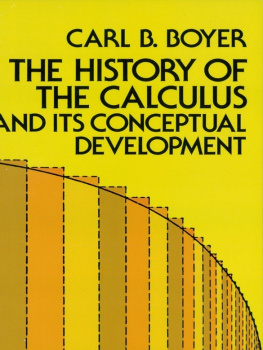Direct Democracy
in Canada
The History and Future
of Referendums
Patrick Boyer
Copyright Patrick Boyer, 1992
All rights reserved. No part of this publication may be reproduced, stored in a retrieval system, or transmitted in any form or by any means, electronic, mechanical, photocopying, recording, or otherwise (except brief passages for purposes of review) without the prior permission of Patrick Boyer, obtained through Dundurn Press Limited. Permission to photocopy should be requested from the Canadian Reprography Collective.
Editing: David McCorquodale
Design and Production: Ron and Ron Design Photography
Cover design: Ron and Ron Design Photography
Printing and Binding: Gagn Printing Ltd., Louiseville, Quebec, Canada
The publisher wishes to acknowledge the generous assistance and ongoing support of The Canada Council, The Book Publishing Industry Development Program of the Department of Communications, The Ontario Arts Council, and The Ontario Publishing Centre of the Ministry of Culture and Communications. The author neither sought nor received any government grants in connection with the writing of this book.
Care has been taken to trace the ownership of copyright material used in the text (including the illustrations). Credit for each quotation is given at the end of the selection. The author and publisher welcome any information enabling them to rectify any reference or credit in subsequent editions.
J. Kirk Howard, Publisher
Canadian Cataloguing in Publication Data
Boyer, J. Patrick
Direct Democracy in Canada
Includes bibliographical references and index.
ISBN 1-55002-183-4
1. Plebiscite Canada History. 2. Referendum Canada History. I. Title.
JF493.C34B7 1992 328.271 C92-095301-8
Dundurn Press Limited | Dundurn Distribution Limited |
2181 Queen Street East | 73 Lime Walk |
Suite 301 | Headington, Oxford |
Toronto, Canada | England |
M4E 1E5 | OX3 7AD |
Dedication
This book is dedicated to the three million, three hundred thousand Canadians with varying degrees of mental and physical disability, most of whom value the dignity of risk in being able to make decisions for themselves regarding their transportation, education, employment, accommodation, and recreation.
Contents
Foreword
When historians come to write about the recent evolution of Canadian parliamentary democracy, Patrick Boyer and his works will be singled out for special attention. In the last few years, most members of Parliament have fallen increasingly out of touch with the country and the people they have been elected to govern. The credibility gap between people and politicians, present to a certain degree in all democracies, has become a widening chasm. Huddled on their well-perked side of it, our members of Parliament and Senators have tended to fault the voters for being irrationally critical and cantankerous, as well as ignorant of the complexities of current issues. The conventional view from Parliament Hill is that it is terribly unfair of voters to elect members to govern the country and then condemn them for making the difficult choices involved in modern government.
Patrick Boyer is virtually unique among our national politicians in understanding that the ongoing health of our political system depends on reforming it to build solid institutional bridges across the gulf between the people and their legislators. This Progressive Conservative MP, well educated in history, understands that the best cure for the ills of democracy is more democracy. For years he has championed the notion that a more frequent reliance on some of the tools of direct democracy, particularly the plebiscite or referendum, can ease Canadians sense of alienation and powerlessness and thus ameliorate the anger they feel towards politicians. This book is a learned, powerful, extended application of Mr. Boyers insights.
The author makes two compelling arguments. First, the devices of direct democracy have been used much more frequently in Canadian political history than most of us realize. He presents exhaustive evidence of our reliance on plebiscites and referendums direct tests of the peoples will to guide us on questions ranging from conscription and the future of Quebec through the marketing of asparagus and the establishment of public libraries. Thousands of plebiscites and referendums have been held in Canadian history. National politicians should note that it is precisely the levels of government thought to be closest to the people municipal and provincial that have formally consulted the people most often. The devices of direct democracy are not foreign to the Canadian political tradition; they are only foreign to a reactionary, elitist doctrine of parliamentary politics, most clearly enunciated in Great Britain some two hundred years ago by Edmund Burke. Mr. Burke died some time ago.
Patrick Boyers second argument is that there are real benefits to be gained in further bending our parliamentary system in the direction of direct democracy, particularly on such major issues as constitutional change. He shows, for example, that the fear of divisiveness is largely mythical. Even the 1942 national conscription plebiscite had the virtue of indicating Canadians real feelings on the issue and should be understood as part of a total process that led to a shorter period of disunity concerning conscription in World War II than was the case after World War I. Generally the magic of holding a vote on an issue is that the losing side accepts defeat graciously (so long as the contest has been fair a further merit of these chapters is the attention Boyer gives to the essential minutiae of holding fair votes) and does not feel cheated or manipulated. Boyer quotes former Conservative Prime Minister Arthur Meighen to good effect: It is the very spirit and genius of British institutions that a minority knows how to submit to the will of a majority, provided it has had a chance first to show its full strength at the poll.
As a history professor, I would like to think that Patrick Boyers training in the discipline of history has given him a broader perspective on current political trends than many of his colleagues. One of the paradoxes of a well-developed sense of history is that it tells us when to stop clinging to an outdated past. Throughout the twentieth century, and particularly in the last three decades, North American society has been evolving very rapidly in the direction of greater individualism. Of course, there are many exceptions, but citizens tend to be better educated, more self-reliant, and less deferential to traditional authorities. We think for ourselves. We make up our own minds. We want to take responsibility for the decisions that control our lives. The crisis of political legitimacy in our times has arisen because people are less willing than ever to delegate powers through the electoral system. The 1990s buzz-word for every organization trying to keep up with modern sensibilities is empowerment. The devices of direct democracy, Patrick Boyer understands, aim in the direction of empowering citizens to govern themselves.
Mr. Boyer has been carrying on his campaign to modernize our political system at a time when most of his colleagues, their consultants, and large chunks of our academic and media communities were still imprisoned by the orthodoxies of the old politics. In the frantic attempt to buttress obsolete Burkean notions of parliamentary democracy, governments developed an immense advertising/manipulation apparatus to persuade voters to go along with whatever the politicians decided. It was a rickety, jerry-built, crumbling structure by the late 1980s and collapsed utterly under the stresses of popular resistance to constitutional deals. In the aftermath of the failure of the Meech Lake accord, the first ministers finally agreed to put their next round, the Charlottetown agreement, to a national vote. When we staged the third national plebiscite in our history, on October 26, 1992, the age of the manipulators and the spin doctors and their kept pollsters came to a dramatic end.


